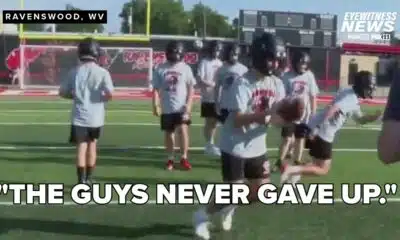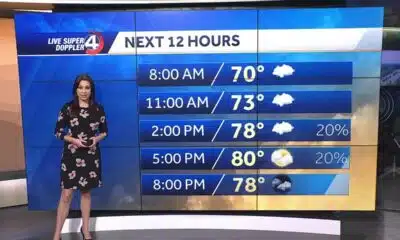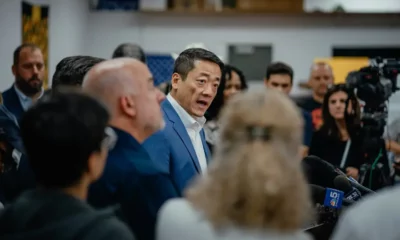News from the South - Missouri News Feed
New Missouri child welfare leader looks for a clean break from the past
by Clara Bates, Missouri Independent
June 23, 2025
In the nearly two decades Sara Smith spent working at Missouri’s Department of Social Services, she remembers nine different people running the agency in charge of investigating child abuse and neglect.
In March, Smith took the helm herself.
She hopes to provide more stability in leading the agency which has seen growing scrutiny over the last several years from nearly every direction — including lawmakers, judges, advocates and the media.
Children’s Division is Missouri’s child welfare agency and is responsible for overseeing foster care, working on frontline child abuse and neglect investigations and managing calls to the child abuse and neglect hotline.
Need to get in touch?
Have a news tip?
There are over 11,000 Missouri children in foster care, as of May, which is down from a peak of over 14,000 in 2021. The state continues to take kids into care at a rate higher than the national average, and is slower to reunite families than the national average.
Children’s Division is acting under a performance improvement plan with the federal government over issues ranging from failure to provide timely permanent placements for kids to caseworkers failing to provide sufficient engagement with parents.
Lawmakers over the years have also raised concern about missing foster kids, unlicensed boarding schools and severe understaffing.
In a brief sit-down with The Independent last week, Smith said she wants to bring Children’s Division back to the basics, which she defines as ensuring safety for children. She highlighted her long experience in the agency, beginning as a frontline child abuse and neglect investigator.
She took over from Darrell Missey, who was outspoken about what he felt was a needed course correction for the agency that was taking too many kids into foster care and keeping them there too long. Missey spent his career as a judge before leading Children’s Division, and his vision reflected a national trend toward family preservation efforts.
Smith, on the other hand, said she doesn’t see reducing the number of kids in foster care as an especially valuable metric. She highlighted several policies during the 30-minute interview, including:
- She supports increasing Temporary Alternative Placement Agreements, which provides removal of children from the home for no more than 90 days into relatives’ care. The parent or guardian voluntarily enters into a TAPA with the Children’s Division, and it can only be done when the child is not in imminent risk. The practice has been criticized nationally and in Missouri as a type of “hidden foster care,” but proponents argue it helps keep kids safe without the trauma of foster care.
- She sees the juvenile office as an important check on Children’s Division’s power, ensuring kids are only being removed when there’s a legally-supported reason. The juvenile office is an agency whose role is unique to Missouri’s child welfare system. Some legal experts have called it unconstitutional. The juvenile office, within the judiciary branch, prosecutes child abuse and neglect cases side-by-side with Children’s Division, and it is responsible for petitioning the court to remove kids, generally upon Children’s Division’s request.
- She noted that there are currently no foster kids residing in offices, a practice that has drawn criticism, but there are several staying in hotels because they don’t have anywhere else to go.
This interview has been edited for length and clarity.
What do you think you bring to the role having spent decades in the agency?
Carrying a caseload as a frontline investigator really helped me understand. I remember the manila folders where I had files for each family, and I would carry those around and try to make sure — have I seen all the kids on this one? Have I seen all the kids on this one? And kind of triaging.
You could be down in Laclede County in Lebanon, and then get a report in Moniteau County and be in California, Missouri. That’s an hour and a half, two hours.
And so just knowing all of those factors, then you have to learn your partners, and every one of those circuits I needed to know law enforcement and courts and juvenile offices and city and county police officers, schools and so just the importance of having those relationships is one of the things that I learned that I think adds value to getting to see the full picture.
Have the first three months on the job been what you expected?
I think it is more [than I expected], very honestly.
Having stepped away from Children’s Division for a couple of years and worked at Family Support Division, and then having an opportunity to work with some of our residential services, there are just different pieces. We have more team members than we did two years ago. We have different-sized caseloads than we had a couple years ago. And so families, I think, coming out of COVID, have more unique sets of circumstances in some areas with the service array available.
And so just being able to understand all that, to know how to help team members, has just been a little bit more challenging than I expected. It is definitely worth all of the time and effort though, that everybody’s putting into it.
Do you think that Children’s Division deserves the scrutiny and reputation that it’s gotten over the last few years?
I think there’s a lot to Children’s Division. Being in it for so long, it’s complicated, and it’s a space that, we respect families’ privacy, and we can only share certain things, and there’s a lot that we can’t share about the work that happens. And that’s really hard sometimes, because you want to be able to share all the complicating factors that are happening and the ins and outs of different pieces. But we can only talk about how the process should work in a best case scenario.
And I don’t think we should necessarily talk about case specifics, because that is a family’s right to privacy. A child’s right to his or her information being kept close to the vest for Children’s Division, but then having the opportunity to be transparent with our stakeholders about what’s happening, what the pain points are and using those systemic things and trends to be able to work with them to create some change.
Because I do think that lack of stability in the Children’s Division director role does play a part in the practice that people see and the partnerships. I think I’ve had nine (directors) since I started Children’s Division, and you know, I’ve heard this from Children’s Division team members like, ‘we’re just going to wait it out. There’ll be somebody else coming in with a different philosophical view.’ Or stakeholders that aren’t sure that you’re going to stay so they don’t take the time to really get to know you or what practice should look like.
Because we’re not adding anything new or different. It’s just following the policy and tools that we have already been provided by the legislators, and really helping support our team. And so I do think that in regard to the scrutiny, some of it is just building that trust factor. And that’s a really big part of our executive team, and I know the department as a whole, is being able to build trust with stakeholders.
You mentioned philosophical differences. What do you see as the main differences between you and former director Darrell Missey?
The director’s role is really hard as I mentioned. You know, being in this spot, everybody comes in with kind of their plan about how to fix the broken system, or how to help support kids and families better.
And I don’t think that anybody would ever enter into this space and take on this role if they didn’t feel like they could make a difference. And so, for me, I think making sure that we are training really the basics, the back to basics.
We have a workforce that really wants to know at the end of the day what their job is from day to day, and not as much of the philosophical, the ‘why’ behind certain practices. They’re not in it for the Social Work degree, in most cases, they are here trying to keep kids safe on a day-to-day basis.
And they want to know the practical tools and what they need to enter into the system, when they should notify the court, when they should reach out to law enforcement.
So just having that expertise, coming from Children’s Division, I think that gives me just a little bit different lens, because I’ve worked in every single program area. And so being able to connect those pieces and know what the hand-off looks like, I think that gives me a little bit different flavor than some previous directors.
Where do staffing issues stand?
The last time that I checked, we had around 52 vacancies statewide, which is really amazing, actually, for Children’s Division. We’re still at around 26% turnover statewide. And of that, 41% of that is our front line workers.
We really hear training is the biggest issue. And so that is one of our main priorities, is revamping the training to make it more practical. We are interested in shortening up the length of time as well that team members are in the initial training now, there’ll be some trainings that, once they get in and get comfortable and kind of know their role, some specialized trainings that we’ll be able to provide.
Do you see training as potentially helping remedy some of the federal issues outlined in the Performance Improvement Plan, such as family engagement?
If you’re not meeting with families, how are you moving the needle towards permanence here, or identifying safety threats? I don’t think we can hang our hat there and not do any other work around things, but I do think solid training is going to set us up for a lot better success.
I’ve heard you say in other interviews that reducing the number of kids in care is not a particularly valuable metric of progress. How should progress be measured?
To me, creating a culture that kids are safe whether they’re in the home, or if there’s a temporary alternative placement agreement in place, that they’re safe in that placement. Or if we have some intensive in-home services or if we may recommend to the juvenile office for removal and place them with a family member or another placement — that we’re really looking at safety no matter what placement the youth is in.
And so, I think that a good metric for us would be: If we’ve had a touch with a family, are we thoroughly assessing safety and having them in the least restrictive setting possible, depending on what the allegations are, and then are we having another touch with that family later on?
Is the way I characterized your thoughts on lowering the number of foster kids accurate?
I think it’s an important metric, but I do think you’re accurate. I think that, it’s really looking at how many calls do we have to the hotline that year? Of those, how many were alerted to the field? Are we seeing kids? So what’s our response time to making sure that we’ve assessed the safety of kids? How fast or thoroughly are we giving families closure? So when are those reports closed? Are we meeting our monthly visits with families…how quickly are they going to permanency?
And then how many kids do we have in care as a metric, but it’s more so, is it that they’re staying in care longer, or are we getting permanency in a timely manner? And so kind of that whole scorecard of our organizational health as an agency. So I wouldn’t drive that on just one metric unless I knew that my number of critical incidents and retouches with our system had gone down as well.
Do you think that Missouri relies too heavily on foster care? That the portion of kids in care is higher here than in other states and people say neglect is often confused with poverty — do you think that’s an issue?
I think we’re lucky in Missouri to have what I would call kind of a bifurcated system. It’s something that a lot of other states don’t have. Children’s Division cannot remove a child. We would recommend removal to the juvenile office. So the juvenile office that’s receiving that referral, they’re making sure that it’s legally sufficient and that we should be recommending removal.
And we have those [referrals] denied from Children’s Division where, Children’s Division might think that there’s a safety threat, the child can’t remain in the home. And the juvenile office might look at it and help us understand why that’s not a legally sufficient avenue.
They’ve been really great partners to us in that space, but having that other look to make sure that you know whatever the concerns are, do meet legal standards, I think helps make me feel better, especially with our turnover rate, that the kids that are in care are actually there for a reason that is legally supported.
So you see the juvenile office as an important check on Children’s Division’s power?
Yeah, and not a lot of other states have that. I mean, they would still go through a hearing in a lot of other states within certain timeframes depending on that state.
But for Children’s Division to have that check on the front end, I think, is something that’s really valuable to us. And so we pull those numbers to look at different circuits. What does removal look like in our partnership with the juvenile office, and I think that’s really important.
You mentioned the temporary alternative placement agreements. In previous years, there’s been some concern — lawmakers have called them uncounted foster kids. Do you have any plans to make data surrounding TAPAs more transparent?
Definitely, that is something that we’ve been messaging, especially with our juvenile office partners, to make sure that they know that our circuit managers can provide them a listing of TAPAs. I mean, they should be notified, but we were hearing from some pockets that they weren’t receiving those notifications. And so we want to make sure that they know that they can continually get a list.
We’re also working on how we could make kind of a public-facing dashboard with that, you know, that’s something that Director Bax, I think, is really big on — the transparency piece.
So figuring out how we can get not just that data, but any of our data that we get a lot of requests for, or that there’s interest in, that we’re making sure to just try to make that as available as possible to, media partners, local counties — sometimes people are interested and they want to know what’s happening in their circuit — and so just trying to make that available.
Why do you think those temporary placements are a tool that the state should rely on more?
Depending on what the concern is, it might be a safety threat that we would be able to mitigate within 30, 60, days, and be able to have supports wrapped around the family and, for the child to go home without entering Children’s Division custody.
And so if that can safely be done, we should definitely be utilizing the TAPA.
It just gives a little bit more formality to what in the old days, it was called a diversion. And I remember diverting a youth from a placement and kind of doing my investigation or assessment, and then there was no policy or procedure at that time, back in 2006, to close the case. And it’s like, okay, well, everything’s safe now, and you just closed it and so, but then that leaves everybody wondering, when can the child go back home? So this process of having a TAPA just really gives, I think, more support to the family.
What about the federal Family First Prevention Services funding? Why do you think Missouri has lagged in spending it and what timeline is there now?
I think that probably the stability in leadership plays a part in that, right?
When you have multiple directors, just that transition, getting a spend plan, or getting that money out the door — I think that’s played a part of it. And just the ability for everyone to understand, since it was a little bit newer, how to do it, I think played a part.
Is it true that a certain amount of money expires in October?
That’s correct. I think it was $10 million in transition funding that we got 2018, 2019, somewhere in there that will expire if it’s not expended by October.
And so that is something that we’re trying to see what we’re able to get out the door by October in a meaningful way to help kids and families. That’s something that we’re definitely looking at, and was on our kind of first quarter plans to look at that and see what we can do.
I hate leaving money on the table. And so if we’re able to utilize that money here in Missouri, you know, let’s do it and let’s get it out the door.
Are you hopeful about utilizing it in time?
I’m optimistic that we’ll be able to get it out the door. Coming in, in the eleventh hour, it kind of doesn’t set me up for the best success as a team for that, but I think we’re going to do our best. This exec team has a lot of support, and we’re going to try to do our best around that.
Regarding the problem with children staying in offices and hotels and residential treatment out of state, what kind of steps are you taking to alleviate those issues? And do you have a sense of how many kids are in those situations?
We definitely don’t have any kids in offices.
We are utilizing hotels. Any time there’s a kiddo in a hotel, we are asking those to be sent up so we can try and help and support to make sure that that doesn’t happen proactively.
That’s a priority. Is getting kids that are placed out of state and residential back into Missouri, and we’re excited about that, working with a lot of partners around what we need.
So this is an issue around higher-acuity youth that people, legislators and stakeholders have been talking about for years.
And so I think we’ve admired the problem enough. I think we know what the problem is. And so how do we jump into some solutions to find them appropriate placement and supports here in Missouri, and to wrap services around them.
It was just Friday that I think at least three of us on the exec team were on a call for numerous hours with partners to try and strategize on how to help. The hospitals have been great partners to us, and so, trying to problem-solve and strategize on getting a youth some supports — and in some areas, there’s just not a lot of supports that are offered. And so how do we help make sure we can do that when there’s nothing in the area for that youth in that family.
It’s something that takes more than just Children’s Division leaning in to help — hospitals, Department of Mental Health, Department of Health and Senior Services. Children’s Division doesn’t offer services. We work with others to get family services, and so we rely a lot on that provider network. Just working with our residential providers and acute and sub acuity settings to try to make sure that they feel that their programming is equipped enough to handle higher acuity youth, is something that almost everybody has come to the table wanting to help.
And so we’re just really excited to see what action steps those individuals take to help Children’s Division and our contracted providers find spaces for these youth.
It’s no secret that DSS has had trouble with its technology being old. I’ve encountered issues getting accurate data through Sunshine Requests, and I know others have had data issues, too. What do you think the roots of those problems are, and how do you plan to address them?
The department has made some efforts on bringing individuals on board that have a lot of IT knowledge. And so we’re excited that they’re in place and can help us in that space.
And so we’re excited to have some IT team members on staff to be able to help us with this, because once we figure out the system and how that’s going to work, then the quality of data will help us be able to help kids and families better, and to be able to intelligently talk about the problems in a better way than we are able to today, to, media and partners.
I like the idea of sharing the data that we have now, whatever is available when we can that protects families’ privacy, because it’s at least a starting place. And that’s what we’re working with today. And so what we have today is what we’re going to use today, and then hope that it’s better as we go along.
Anything else?
Overall, I’m really excited to see over the next few months, and I would say, especially in a year — where Children’s Division is at in a year with our policy and practice and new training.
I think we’re going to be in a vastly different space than for people feeling comfortable in their work, and that’s what I’m most excited about, because when people feel comfortable and stakeholders trust us, then it’s only going to equal good things for kids and families.
Your Donations Make Our Journalism Possible
As a nonprofit newsroom, our articles are free for everyone to access. Readers like you make that possible. Can you help sustain our watchdog reporting today?
Missouri Independent is part of States Newsroom, a nonprofit news network supported by grants and a coalition of donors as a 501c(3) public charity. Missouri Independent maintains editorial independence. Contact Editor Jason Hancock for questions: info@missouriindependent.com.
The post New Missouri child welfare leader looks for a clean break from the past appeared first on missouriindependent.com
Note: The following A.I. based commentary is not part of the original article, reproduced above, but is offered in the hopes that it will promote greater media literacy and critical thinking, by making any potential bias more visible to the reader –Staff Editor.
Political Bias Rating: Centrist
The article takes a factual, in-depth approach to Missouri’s Children’s Division, focusing on agency leadership, performance, and child welfare policy challenges without overt ideological framing. It presents direct quotes from Director Sara Smith and background on systemic problems but avoids language that assigns partisan blame or promotes a specific ideological solution. The piece gives space to different views (such as previous director Darrell Missey’s push for family preservation and Smith’s alternative priorities) and references both criticisms and improvements, highlighting operational realities rather than political arguments. The tone is measured, informative, and largely neutral, with balanced sourcing and little sign of editorial slant.
News from the South - Missouri News Feed
Urban League's back-to-school expo helps thousands of St. Louis students in need
SUMMARY: The Urban League’s back-to-school expo in St. Louis provided crucial support to thousands of students in need. Held in a drive-thru format, the event served up to 5,000 families, distributing nearly $400,000 worth of school supplies, food, groceries, toiletries, PPE, and tornado disaster relief items. Sponsored by Nike and community partners, the expo ensured children had essential tools to start the school year strong, especially important after recent severe weather devastation. Volunteers efficiently loaded supplies into cars to ensure safety and accessibility. A follow-up event on August 16 will offer free health services including exams, immunizations, and screenings.
Thousands of students get a big boost ahead of the new school year as the Urban League of Metropolitan St. Louis’ back-to-school expo returned this weekend.
St. Louis News: FOX 2 covers news, weather, and sports in Missouri and Illinois. Read more about this story or see the latest updates on our website https://FOX2Now.com
Follow FOX 2 on social media:
YouTube: https://www.youtube.com/FOX2Now
Facebook: https://www.facebook.com/FOX2Now/
Twitter: https://twitter.com/FOX2Now/
Instagram: https://www.instagram.com/fox2now/
TikTok: https://tiktok.com/@fox2now
SnapChat: https://www.snapchat.com/add/fox2now
News from the South - Missouri News Feed
Here's what Yadier Molina said on his first game as a Cardinals coach
SUMMARY: Yadier Molina, the St. Louis Cardinals’ legendary catcher, returned to Busch Stadium as a guest coach for the first time since retiring three years ago. Serving for two games against the Chicago Cubs, Molina is providing moral support and sharing his expertise with catchers and pitchers to refine their skills during the 2025 season’s final months. He expressed joy in returning home, appreciating the fans and the opportunity to mentor young players. Manager Oli Marmol and catchers Yohel Pozo and Pedro Pages praised Molina’s presence and impact. Molina also revealed aspirations to manage or coach at the major league level in the future.
The post Here's what Yadier Molina said on his first game as a Cardinals coach appeared first on fox2now.com
News from the South - Missouri News Feed
Local movie: Catching Bullets
SUMMARY: “Catching Bullets” is a powerful new documentary addressing youth gun violence in St. Louis, following community leaders and mentors working to break the cycle. The film centers on former gang member Darren Seals, who survived multiple shootings and now dedicates his life to helping at-risk youth find constructive paths. It highlights gun violence as the leading cause of death for Black males in St. Louis and emphasizes the need for community-driven change. Premiering locally on the 14th and streaming nationally on Tubi and Amazon Prime, the film aims to inspire hope, healing, and a return to caring community values.
Thursday, August 14th 24:1 Cinema
6755 Page Avenue
Pagedale, Mo 6:30 p.m.
-
Mississippi Today6 days ago
After 30 years in prison, Mississippi woman dies from cancer she says was preventable
-
News from the South - Texas News Feed6 days ago
Texas redistricting: What to know about Dems’ quorum break
-
News from the South - North Carolina News Feed4 days ago
Two people unaccounted for in Spring Lake after flash flooding
-
Mississippi Today6 days ago
Brain drain: Mother understands her daughters’ decisions to leave Mississippi
-
News from the South - Texas News Feed7 days ago
Pritzker says Texas Democrats who fled state will be protected amid arrest threats
-
News from the South - Georgia News Feed6 days ago
29-year-old killed after driving off road in 'dangerous' section road | FOX 5 News
-
News from the South - Louisiana News Feed7 days ago
Plans for Northside library up for first vote – The Current
-
Local News Video7 days ago
Sparklight offers free backpacks and school supplies to Coast kids











































